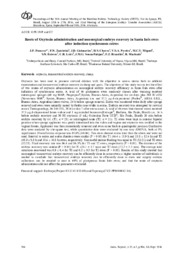Route of Oxytocin administration and nonsurgical embryo recovery in Santa Inês ewes after induction synchronous estrus.
Route of Oxytocin administration and nonsurgical embryo recovery in Santa Inês ewes after induction synchronous estrus.
Author(s): FONSECA, J. F. da; ZAMBRINI, F. N.; PEREIRA, V. S. do A.; CHAVES, D. S.; PEREIRA, V. S. A.; ESTEVES, S. N.; ESTEVES, S. N.; LEITE, C. R.; FABJAN, J. M. G. S.; BRANDÃO, F. Z.; MACHADO, R.
Summary: Abstract: Oxytocin has been used to promote cervical dilation with the objective to access uterus both in artificial insemination and transcervical embryo recovery in sheep and goats. The objective of this study was to test the effect of two routes of oxytocin administration on nonsurgical embryo recovery efficiency in Santa Inês ewes after induction of synchronous estrus. A total of 46 pluriparous ewes randomly chosen after weaning received intravaginal sponges (60 mg MAP; Progespon®,Syntex, Buenos Aires, Argentina) for six days plus 200 IU eCG (Novormon 5000®, Syntex, Buenos Aires, Argentina) i.m. and 37.5 ?g d-cloprostenol (Prolise®, ARSA S.R.L., Buenos Aires, Argentina) latero-vulvar, 24 h before sponge removal. Estrus was monitored twice daily after sponge removal and ewes were naturally mated by fertile rams while in estrus. Embryo recovery was attempted by cervical route (Theriogenology, 86:144-151, 2016) at day 7 after estrus onset. A total of 46 ewes that showed estrus received 37.5 ?g d-cloprostenol latero-vulvar and 1 mg estradiol benzoate (Estrogin®, Biofarm, São Paulo, Brazil) i.m. 16 h before embryo recovery and 50 IU oxytocin (5 mL; Ocitocina Forte UCB®, São Paulo, Brazil) 20 min before embryo recovery by i.v. (T1; n = 21) or intravaginal route (T2; n = 21). T2 ewes were kept in anterior bipedal position when sponge applicator was gently introduced into the vulva and vagina and oxytocin was instilled in the vaginal fornix. Applicator was then immediately removed and ewes came back to quadrupedal position. Qualitative data were analyzed by chi-square test, while quantitative data were evaluated by one way ANOVA, both at 5% significance. Overall estrus response was 95.6% (44/46). Two ewes showed estrus later than the others and were not used. Interval to estrus and estrus duration were similar (P > 0.05) for T1 (46.4 ± 11.9 h and 33.8 ± 12.6 h) and T2 (48.0 ± 9.8 h and 31.6 ± 10.8 h) ewes, respectively. Successful uterine flushing was equal to T1 (12/21) and T2 ewes (12/21). Fluid recovery rate was 96.4 and 96.5% for T1 and T2 ewes, respectively (P > 0.05). The duration of the embryo recovery was similar (P > 0.05) for T1 (24.1 ± 5.7 min) and T2 ewes (23.2 ± 5.3 min). The average total structures recovered was 0.9 ± 0.4 for T1 and 0.5 ± 0.5 for T2 ewes (P > 0.05). Results of this study showed that nonsurgical transcervical embryo recovery can be efficiently done in some ewes; a higher number of individuals is needed to conclude that transcervical embryo recovery can be efficiently done in ewes and surgery embryo collections can be avoided in near to 60% of pluriparous Santa Inês ewes; and that the route of oxytocin administration did not affect the parameters evaluated.
Publication year: 2016
Types of publication: Abstract in annals or event proceedings
Unit: Embrapa Goats & Sheep
Observation
Some of Embrapa's publications are published as ePub files. To read them, use or download one of the following free software options to your computer or mobile device. Android: Google Play Books; IOS: iBooks; Windows and Linux: Calibre.
Access other publications
Access the Agricultural Research Database (BDPA) to consult Embrapa's full library collection and records.
Visit Embrapa Bookstore to purchase books and other publications sold by Embrapa.

